Creating a Rock Garden that Rocks --With Hostas!
A rock garden by design is a small plot (usually on a slope or man-made hill) designed to emphasize a variety of rocks, stones, and plants. Rock gardens can be made to blend into the landscape or they can be a great focal point area. Rocks are naturally beautiful, and with the right planning, your rock garden will look good year-round.
Why hostas are THE best plants for rock gardens
Simply, hostas have all the necessary elements of a great rock garden plant:
- They are perennials in Zones 3 – 9. There's no need to replace them year after year.
- They are well known to be tough plants that can be grown in many different environments and soils.
- They are easy to maintain.
- Their leaf structure. Hostas are known for their beautiful leaves that are available in many shapes which include narrow, lance-shaped, heart-shaped, rounded, apple-shaped and those cute mouse ear shapes. The leaf textures range from thin to thick and corrugated or rugose.
- They come in many sizes. Hostas are categorized in sizes from very large, to large, to medium to the mini and small hostas. The later will not outgrow their space quickly.
- They come in many colors including blues, greens, yellows, golds and variegated colors.
- Once established hostas are practically drought tolerant.
- Some hostas are also sun tolerant and slug resistant.
- Their clump-forming habit will quickly smother out weeds.
First, some Rock Garden basics
About the Soil
Generally, the soil should drain well but not too fast.
For a rock garden in a sunny spot, before planting, mix small rocks, a layer of sand and a layer of topsoil with some peat moss and you will have the best soil you can get for your rock garden.
For a rock garden in a shadier spot, a richer soil mix like compost is recommended since most shade-loving plants prefer a moisture retentive mixture.
Staging the Rocks
The rocks will complement the delicacy of the plants and flowers within it. The trick is to use a variety of textures and scale. This is where it may be helpful to map out your plan on paper.
- Start with the large rocks. Random groups look more natural than straight lines and rows. Use a combination of upright rocks, rounded rocks, and hard-edged rocks. You can also stack them for some extra height.
- The rocks can be placed so that the same rock can shadow a shade-loving plant on the northern side, and give plenty of southern light to the plants on the other side.
- Rocks should be tilted backward with the layers of rock running the same way.
- Bury the large rocks up to a third of their depth and firm into place. You don't want your final project heaving up from the winter's freezes and thaws.
- Leave large pockets to add smaller rocks, stones or plants.
Next Steps
- Now incorporate smaller stones or rocks leaving small pockets for the plants.
- Add the soil between the rocks and into pockets.
Step back. Does it look natural?
The more natural your rock garden looks at this point, the more attractive it will be after it's planted.
Let it settle
Once you're happy with the basic structure, it is advisable to leave the rock garden to settle in for a few weeks. You may need to adjust more soil after some settlement. Better to do that before planting.
Now for the Fun Part! The Plants!
As a rule, for bigger rocks, bigger plants are needed. For smaller rocks, smaller plants are needed. Flowers should accent the rocks, but not hide them.
Here at Sunset Hosta Farm, we grow and sell a number of hostas that are suitable for rock gardens. Here are some hostas that we recommend for rock gardens in part shade.
Praying Hands
Mature Size: Small Height: 16” Width up to 30”
Praying Hands is the 2011 Hosta of the Year and one of the most unique hostas ever. This upright 16” tall two-foot-wide clump lives up to its name lifting its leaves up in prayer. The clumps are topped with 18” spikes of light lavender flowers. It has a creamy narrow yellow border. In late spring it will attract hummingbirds. A unique and very popular hosta.
Rain Forest Sunrise
Mature Size: Small Height: 10” Width up to 35”
This sport of H 'Maui Buttercups' emerges with light green leaves that quickly develop dark green margins. The leaves are cupped and puckered with great substance. It was awarded the 2013 Hosta of the Year for good reason. Pictures don’t do this hosta justice.
Saint Elmo's Fire
Mature Size: Small Height: 10” Width up to 30”
A sport of H 'Sea Fire', Saint Elmo's Fire is a true beauty that is noted for its showy yellow leaves. As the season progresses, the leaves turn light green with pretty white margins. A very attractive bi-colored foliage display. It's a stunner!
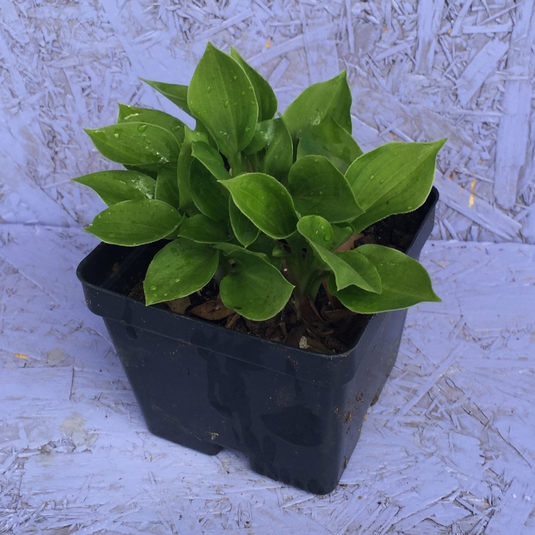
Teaspoon
Mature Size: Small Height: 11” Width up to 24”
Teaspoon is an excellent choice to show off in front of a shady garden. The leaves are medium green, slightly corrugated and form a dense mound of cupped, upward-facing foliage. Pale lavender flowers show up in summer. A very pretty small green hosta that is sun tolerant.
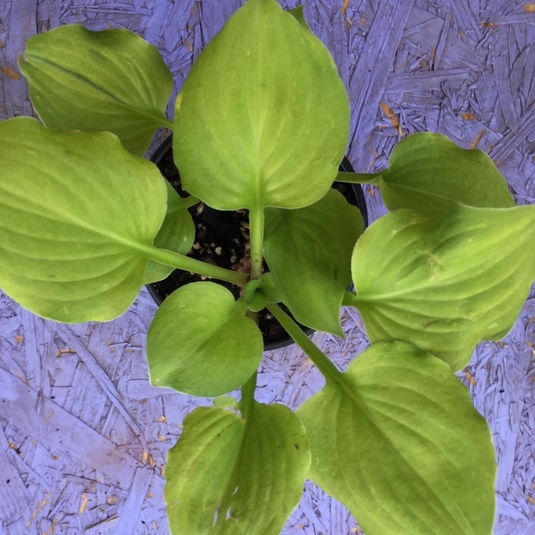
Amber Tiara
Mature Size: Small Height: 12” Width up to 20”
Amber Tiara has thick chartreuse oval-shaped leaves with a blunt tip. It forms an attractive dense mound. The flowers are light purple on 22” scapes in late summer. Give this Tiara more sun for its best color.
Mini and Small Sun Tolerant Hostas
Mini and Small Sun Tolerant Hostas
These hostas can take more sun than their shade-loving cousins, up to four to six hours of morning sun with afternoon shade. They will also work well in a shady spot.
Friends
Mature Size: Small Height: 9” Width up to 24”
Friends grow into a small mound of rippled gold foliage. The tips of the leaves are slightly twisted. The leaves will brighten to yellow by mid-summer. It's a reliable, fast grower. Displays lavender to white throats in late summer. Looks great in groups and in the front of a hosta bed. Small and very cute.
Hush Puppie
Mature Size: Mini Height: 7” Width up to 15”
Hush Puppie is the perfect border or edging plant because of its vigorous growth rate and smaller size. It has cute twisted dark green leaves with white creamy edges. It blooms purple in early summer. Great for fairie gardens, rock gardens, and troughs and especially cute when planted en masse.
Blue Mouse Ears
Mature Size: Mini Height: 8” Width up to 19”
2008 Hosta of the Year for good reason! The medium blue/green mouse ear-shaped leaves are nothing short of adorable! Outstanding lavender to white lily-like flowers atop graceful stalks in summer. Great for rock gardens, fairy gardens, and borders. Very popular and a must-have for any hosta garden.
Green Mouse Ears
Mature Size: Mini Height: 8” Width up to 19”
Green Mouse Ears is a cute little sport of 'Blue Mouse Ears'. Green Mouse Ears forms a mound of medium to dark green cupped leaves of good substance. Pale purple flowers rise above the upright leaves in the summer. Also slug resistant. Very cute!
Mighty Mouse
Mature Size: Mini Height: 8” Width up to 19”
A sport of H 'Blue Mouse Ears', this charmer boasts thick round variegated leaves with a creamy margin. It will attract hummingbirds in late spring with its short spikes of dark lavender flowers. Cute! A must-have for any mouse-ear collector.
Other suitable plants for your rock garden
Other suitable plants for your rock garden
For some added color, these plants are also suitable for rock gardens. Some of these may be fast growers and may need to be divided or replaced more often than the hostas would.
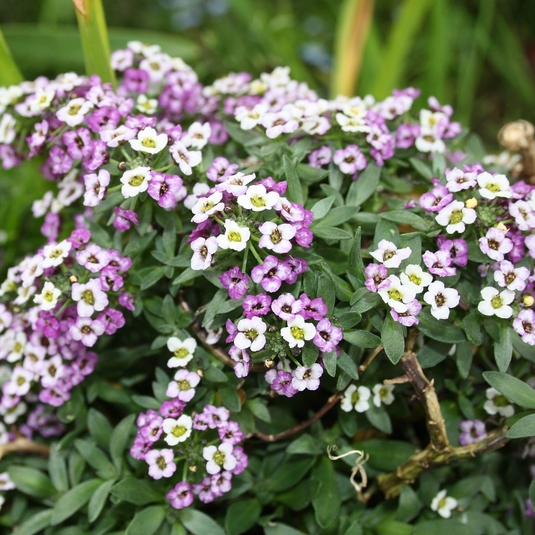
Alyssum
Perennial Zones 3 – 9 Height 6-12”
A perennial alyssum that develops masses of cheerful flowers that look terrific when tucked between rocks and boulders.
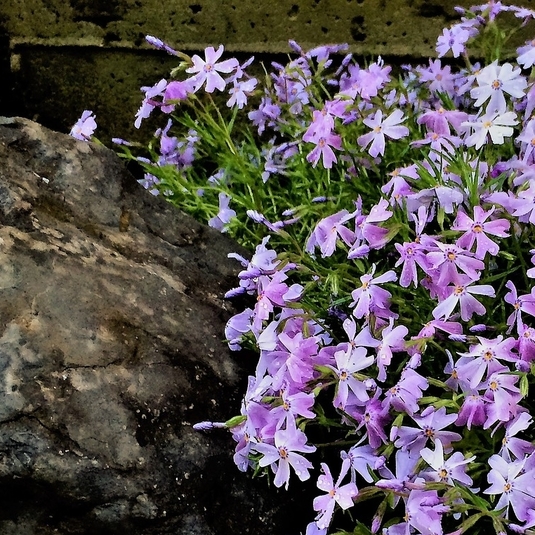
Creeping Phlox aka Phlox Subulata or Moss Pink
Perennial Zones 3 – 9 Height 6-12”
A mat-forming perennial with pink blooms. Spreads to two feet. You can shear the foliage back after it blooms.
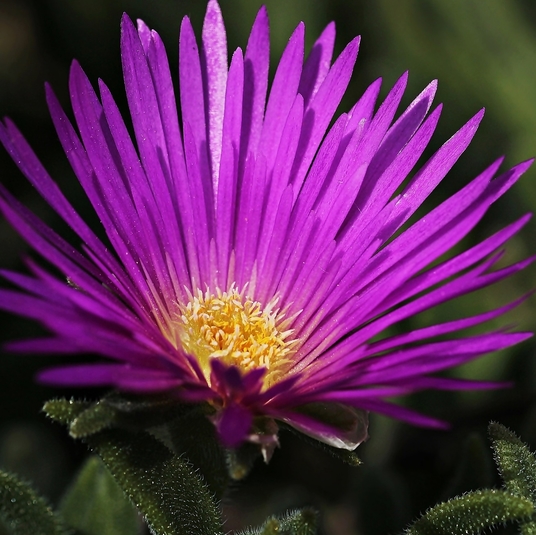
Ice Plant
Perennial Zones 5 – 9 Height 3”
This perennial will stay short but can spread to three or four feet. It will bloom most of the summer and fall. The leaves morph into darker colors as the temperature drops.
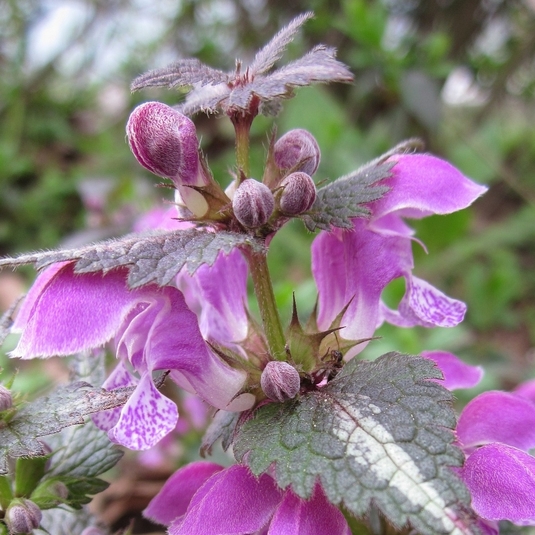
Lamium aka Deadnettle
Perennial Zones 2 – 9 Height 6-8”
A member of the mint family, Lamium has square stems, toothed leaves, and a spreading habit. The foliage can be mottled, frosted or otherwise marked.
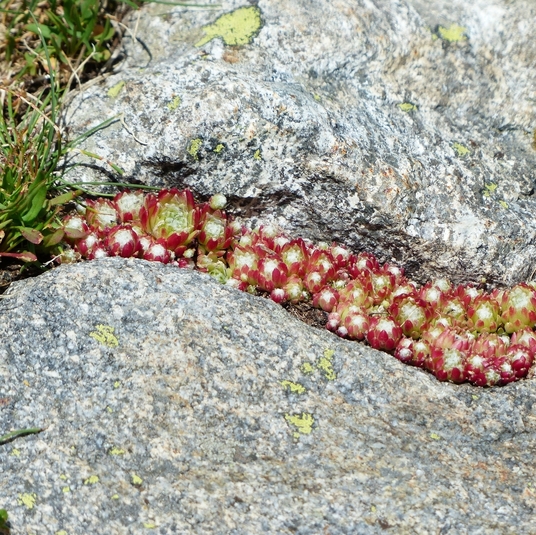
Sedum
Perennial Zones 3 – 11 Height 3-6”
Any type of low-growing sedum looks great in rock gardens, Crassulaceae and Hens and Chicks to name a few.
Angelina has brilliant chartreuse needle-like foliage that forms a quick-growing ground cover. Excellent year-round coverage. The foliage turns orange in northern climates.
Dragon's Blood is evergreen except in the coldest areas. Its green leaves with red margins turn a brilliant red with cool autumn temperatures. Its deep red flowers contrast with the green leaves in warmer weather. It needs part to full sun.
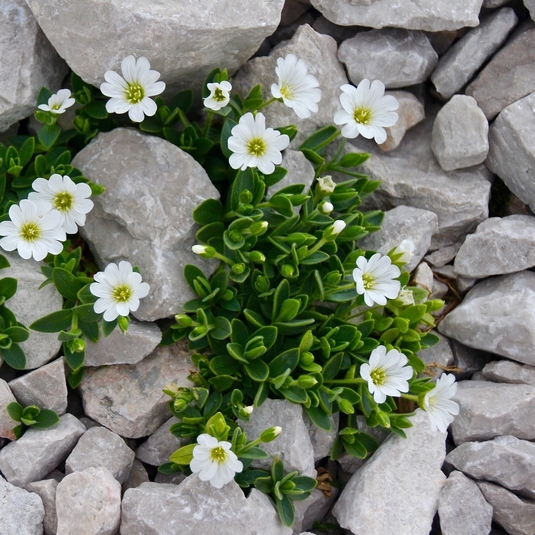
Snow-in-the-Summer
Perennial Zones 3 - 7 Height 6" Width 1'
Snow-in-the-Summer blooms white in July. It's a great ground cover.
Other Design Tips
Allow the leaves of your plants to cascade over a corner of the rock then plant a smaller plant in front of the rock. This gives you the classic three groupings without using three plants.
Planting three hostas one foot apart in a triangle with a large rock in the middle also gives a nice effect.
Mulching Your Rock Garden
Bark mulches can look out of place in a rock garden. Use small stone for mulch, matching the same color as the larger rocks to blend in.


Care for your Rock Garden
Care for your Rock Garden
- Weed frequently at first until the rocks and plants establish themselves in the soil.
- Water occasionally and deeply.
- Prune plants that have spread beyond their limits.
- Move plants that appear unhappy.
- In the fall, rake out fallen leaves and cover any weather sensitive plants.
~~~~~~~~~~
It's not a surprise that mini and small hostas are becoming the number one plant for rock gardens. You'll be hard-pressed to find another perennial as rugged and carefree as a hosta.
~~~~~~~~~~

















.png)






This comment has been removed by a blog administrator.
ReplyDelete